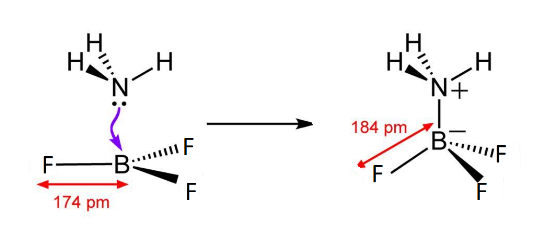Question
Question: The formation of molecular complex \[B{F_3} - N{H_3}\] results in a change in hybridization of boron...
The formation of molecular complex BF3−NH3 results in a change in hybridization of boron:
(A) From sp2 to dsp2
(B) From sp2 to sp3
(C) From sp3 to sp2
(D) From sp3 to sp3d
Solution
NH3 is electron rich as it has a lone pair and BF3 is electron deficient, due to this, ammonia donates its electron pair to BF3 , which has vacant orbital that takes up electrons and completes its octet by forming a coordinate bond and changing its hybridisation.
Complete step-by-step solution:
NH3 is an electron-rich species with a lone pair on a Nitrogen atom and so it is always ready to either share or donate this lone pair to other species. Therefore, it is known as a Lewis base. Lewis bases can donate a pair of non-bonding electrons.
While, BF3 is an electron-deficient species having vacant orbitals with an incomplete octet of Boron. So BF3 always looks for species which can donate electrons to it and complete its octet. Therefore, it is known as Lewis acid. These are electron acceptors.
So, when they come close to each other to form a bond, an ammonia molecule coordinates its lone pair to the empty p-shell or vacant p-orbitals of Boron forming a co-ordinate bond to give rise to an adduct which looks like this.

BF3 has a hybridisation of sp2 because of filling of 2s and 2 orbitals of 2p. But as it forms coordinate bond with ammonia, the lone pair accepted from ammonia leads to bond pair and lone pair repulsion, changing its shape from trigonal planar to tetrahedral and hybridisation from sp2 to sp3 due to filling of one more 2p orbital. This makes the system highly stable by removing the electron deficiency of boron.
Hence, the correct option is (B).
Note: As per molecular orbital theory, one can also understand this concept as the HOMO on the Lewis base (NH3) interacts with the electron pair in the LUMO of the Lewis acid (BF3). This forms an adduct of these molecular orbitals and lowers the energy by stabilizing it.
